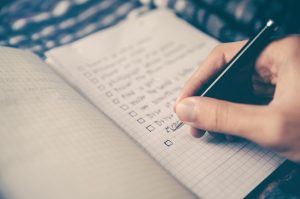3.3 – Outlining
Learning Objectives
- Identify the steps in constructing an outline.
- Construct a topic outline and a sentence outline.
Your prewriting activities and research have helped you gather information for your assignment. The more you sort through the pieces of information you found, the more you will begin to see the connections between them. Patterns and gaps may begin to stand out. But only when you start to organize your ideas will you be able to translate your raw insights into a form that will communicate meaning to your audience.
Tip
Longer papers require more reading and planning than shorter papers do. Most writers discover that the more they know about a topic, the more they can write about it with intelligence and interest.
Organizing Ideas
When you write, you need to organize your ideas in an order that makes sense. The writing you complete in all your courses exposes how analytically and critically your mind works. In some courses, the only direct contact you may have with your instructor is through the assignments you write for the course. You can make a good impression by spending time ordering your ideas.
Order refers to your choice of what to present first, second, third, and so on in your writing. The order you pick closely relates to your purpose for writing that particular assignment. In longer pieces of writing, you may organize different parts in different ways so that your purpose stands out clearly and all parts of the paper work together to consistently develop your main point.
Methods of Organizing Writing
The three common methods of organizing writing are chronological order , spatial order , and order of importance . You will learn more about these in “Writing Essays: From Start to Finish”; however, you need to keep these methods of organization in mind as you plan how to arrange the information you have gathered in an outline. An outline is a written plan that serves as a skeleton for the paragraphs you write. Later, when you draft paragraphs in the next stage of the writing process, you will add support to create “flesh” and “muscle” for your assignment.
When you write, your goal is not only to complete an assignment but also to write for a specific purpose—perhaps to inform, to explain, to persuade, or for a combination of these purposes. Your purpose for writing should always be in the back of your mind, because it will help you decide which pieces of information belong together and how you will order them. In other words, choose the order that will most effectively fit your purpose and support your main point.
| Order | Purpose |
| Chronological Order |
To explain the history of an event or a topic
To explain how to do or make something To tell a story or relate an experience To explain the steps in a process |
| Spatial Order | To help readers visualize something as you want them to see it
To create a main impression using the senses (sight, touch, taste, smell, and sound) |
| Order of Importance | To persuade or convince
To rank items by their importance, benefit, or significance |
Writing a Thesis Statement
One legitimate question readers always ask about a piece of writing is “What is the big idea?” (You may even ask this question when you are the reader, critically reading an assignment or another document.) Every nonfiction writing task—from the short essay to the ten-page term paper to the lengthy graduate thesis—needs a big idea, or a controlling idea, as the spine for the work. The controlling idea is the main idea that you want to present and develop.
Tip
For a longer piece of writing, the main idea should be broader than the main idea for a shorter piece of writing. Be sure to frame a main idea that is appropriate for the length of the assignment. Ask yourself, “How many pages will it take for me to explain and explore this main idea in detail?” Be reasonable with your estimate. Then expand or trim it to fit the required length.
The big idea, or controlling idea, you want to present in an essay is expressed in a thesis statement . A thesis statement is often one sentence long, and it states your point of view. The thesis statement is not the topic of the piece of writing but rather what you have to say about that topic and what is important to tell readers. Table 2 – “Topics and Thesis Statements” compares topics and thesis statements.
| Topic | Thesis Statement |
|---|---|
| Music piracy | The recording industry fears that so-called music piracy will diminish profits and destroy markets, but it cannot be more wrong. |
| The number of consumer choices available in media gear | Everyone wants the newest and the best digital technology, but the choices are extensive, and the specifications are often confusing. |
| E-books and online newspapers increasing their share of the market | E-books and online newspapers will bring an end to print media as we know it. |
| Online education and the new media | Someday, students and teachers will send avatars to their online classrooms. |
Watch How to write a thesis statement on YouTube (3 mins)
Video Source: HACC, Central Pennsylvania’s Community College. (2014, November 21). How to write a thesis statement [Video]. YouTube. http://youtu.be/a9gBh771Qbg
The first thesis statement you write will be a preliminary thesis statement, or a working thesis statement . You will need it when you begin to outline your assignment as a way to organize it. As you continue to develop the arrangement, you can limit your working thesis statement if it is too broad or expand it if it proves too narrow for what you want to say.
Exercise 1
Tip
You will make several attempts before you devise a working thesis statement that you think is effective. Each draft of the thesis statement will bring you closer to the wording that expresses your meaning exactly.
Writing an Outline

For an essay question on a test or a brief oral presentation in class, all you may need to prepare is a short, informal outline in which you jot down key ideas in the order you will present them. This kind of outline reminds you to stay focused in a stressful situation and to include all the good ideas that help you explain or prove your point.
For a longer assignment, like an essay or a research paper, many college instructors require students to submit a formal outline before writing a major paper as a way to be sure you are on the right track and are working in an organized manner. A formal outline is a detailed guide that shows how all your supporting ideas relate to each other. It helps you distinguish between ideas that are of equal importance and ones that are of lesser importance. You build your paper based on the framework created by the outline.
Tip
Instructors may also require you to submit an outline with your final draft to check the direction of the assignment and the logic of your final draft. If you are required to submit an outline with the final draft of a paper, remember to revise the outline to reflect any changes you made while writing the paper.
There are two types of formal outlines: the topic outline and the sentence outline. You format both types of formal outlines in the same way.
- Place your introduction and thesis statement at the beginning, under roman numeral I.
- Use Roman numerals (II, III, IV, V, etc.) to identify main points that develop the thesis statement.
- Use capital letters (A, B, C, D, etc.) to divide your main points into parts.
- Use Arabic numerals (1, 2, 3, 4, 5, etc.) if you need to subdivide any As, Bs, or Cs into smaller parts.
- End with the final roman numeral expressing your idea for your conclusion.
Here is what the skeleton of a traditional formal outline looks like. The indention helps clarify how the ideas are related.
- Introduction
- Thesis statement
- Main point 1 → becomes the topic sentence of body paragraph 1
Tip
In an outline, any supporting detail can be developed with subpoints. For simplicity, the model shows them only under the first main point.
Tip
Formal outlines are often quite rigid in their organization. As many instructors will specify, you cannot subdivide one point if it is only one part. For example, for every roman numeral I, there must be a II. For every A, there must be a B. For every arabic numeral 1, there must be a 2. See for yourself on the sample outlines that follow.
Constructing Topic Outlines
A topic outline is the same as a sentence outline except you use words or phrases instead of complete sentences. Words and phrases keep the outline short and easier to comprehend. All the headings, however, must be written in parallel structure. (For more information on parallel structure, see “Refining Your Writing: How Do I Improve My Writing Technique?”.)
Here is the topic outline that Mariah constructed for the essay she is developing. Her purpose is to inform, and her audience is a general audience of her fellow college students. Notice how Mariah begins with her thesis statement. She then arranges her main points and supporting details in outline form using short phrases in parallel grammatical structure. She also makes a note of which source(s) she will use to support her ideas.
Mariah’s Topic Outline
- Introduction
– Thesis statement: Everyone wants the newest and the best digital technology, but the choices are many, and the specifications are often confusing. - E-book readers and the way that people read – Information from (Baron, 2015)
- Books easy to access and carry around
- Electronic downloads
- Storage in memory for hundreds of books
- An expanding market
- E-book readers from booksellers
- E-book readers from electronics and computer companies
- Limitations of current e-book readers
- Incompatible features from one brand to the next
- Borrowing and sharing e-books
- Books easy to access and carry around
- Film cameras replaced by digital cameras – Information from (It takes a camera, 2011)
- Three types of digital cameras
- Compact digital cameras
- Single lens reflex cameras, or SLRs
- Cameras that combine the best features of both
- The confusing “megapixel wars.”
- The zoom lens battle
- Three types of digital cameras
- The confusing choice among televisions – Information from (Hall, 2018)
- Resolution
- Backlighting and High Dynamic Range
- Home media centers
- Conclusion
– How to be a wise consumer
References
Baron, N.S. (2015). Words Onscreen : The Fate of Reading in a Digital World. Oxford University Press.
Hall, P. (2022, March 30). How to choose the right TV. Wired. https://www.wired.com/story/how-to-buy-the-right-tv/
It takes a camera. (2011). Consumer Reports, 76(8), 38-47.
Writing an Effective Topic Outline – Checklist

This checklist can help you write an effective topic outline for your assignment. It will also help you discover where you may need to do additional reading or prewriting.
- Do I have a controlling idea that guides the development of the entire piece of writing?
- Do I have three or more main points that I want to make in this piece of writing? Does each main point connect to my controlling idea?
- Is my outline in the best order—chronological order, spatial order, or order of importance—for me to present my main points? Will this order help me get my main point across?
- Do I have supporting details that will help me inform, explain, or prove my main points? Have I verified these details with support from sources?
- Have I made a note of which sources I used? Do I have all the information I need for my reference list?
- Do I need to add more support? If so, where?
- Are there credible sources that provide enough information?
- Do I need to make any adjustments in my working thesis statement before I consider it the final version?
Writing at Work
Exercise 2
Constructing Sentence Outlines
A sentence outline is the same as a topic outline except you use complete sentences instead of words or phrases. Complete sentences create clarity and can advance you one step closer to a draft in the writing process.
Here is the sentence outline that Mariah constructed for the essay she is developing.
Mariah’s Sentence Outline
- Introduction
– Thesis statement: Everyone wants the newest and the best digital technology, but the choices are many, and the specifications are often confusing. - E-book readers are changing the way people read.
- E-book readers make books easy to access and to carry (Baron, 2015).
- Books can be downloaded electronically.
- Devices can store hundreds of books in memory.
- The market expands as a variety of companies enter it (Baron, 2015).
- Booksellers sell their own e-book readers.
- Electronics and computer companies also sell e-book readers.
- Current e-book readers have significant limitations (Baron, 2015).
- The devices are owned by different brands and may not be compatible.
- Few programs have been made to fit the other way people read by borrowing books from libraries
- E-book readers make books easy to access and to carry (Baron, 2015).
- Digital cameras have almost totally replaced film cameras
- The first major choice is the type of digital camera (It takes a camera, 2011).
- Compact digital cameras are light but have fewer megapixels
- Single lens reflex cameras, or SLRs, may be large and heavy but can be used for many functions.
- Some cameras combine the best features of compacts and SLRs.
- Choosing the camera type involves the confusing “megapixel wars.” (It takes a camera, 2011).
- The zoom lens battle also determines the camera you will buy. (It takes a camera, 2011).
- The first major choice is the type of digital camera (It takes a camera, 2011).
- Nothing is more confusing to me than choosing among televisions.
- In the resolution wars, what are the benefits higher resolution? (Hall, 2022)
- What is Edge lighting and High Dynamic Range mean? (Hall, 2022)
- Does every home really need a media center?
- Conclusion
– The solution for many people should be to avoid buying on impulse. Consumers should think about what they really need, not what is advertised.
References
Baron, N.S. (2015). Words Onscreen : The Fate of Reading in a Digital World. Oxford University Press.
Hall, P. (2022, March 30). How to choose the right TV. Wired. https://www.wired.com/story/how-to-buy-the-right-tv/
It takes a camera. (2011). Consumer Reports, 76(8), 38-47.
Topic Outlines vs. Sentence Outlines
Topic Outlines vs. Sentence Outlines (Text version)
- A topic outline focuses on the topic of the essay, while a sentence outline focuses on the controlling idea of the essay.
- A topic outline is written in short phrases, while a sentence outline is written in complete sentences that provide a little more information.
- A topic outline is laid out using roman numerals, while a sentence outline uses letters and numbers.
Check your Answers: [1]
Activity source: “Topic Outline vs Sentence Outline” by Emily Cramer is licensed under CC BY-NC 4.0
Tip
The information compiled under each roman numeral will become a paragraph in your final paper. In the previous example, the outline follows the standard five-paragraph essay arrangement, but longer essays will require more paragraphs and thus more roman numerals. If you think that a paragraph might become too long or stringy, add an additional paragraph to your outline, renumbering the main points appropriately.
Exercise 3
Key Takeaways
- Writers must put their ideas in order so the assignment makes sense. The most common orders are chronological order, spatial order, and order of importance.
- After gathering and evaluating the information you found for your essay, the next step is to write a working, or preliminary, thesis statement.
- The working thesis statement expresses the main idea that you want to develop in the entire piece of writing. It can be modified as you continue the writing process.
- Effective writers prepare a formal outline to organize their main ideas and supporting details in the order they will be presented.
- A topic outline uses words and phrases to express the ideas.
- A sentence outline uses complete sentences to express the ideas.
- The writer’s thesis statement begins the outline, and the outline ends with suggestions for the concluding paragraph.
- Making note of your supporting sources in the outline stage will help you avoid plagiarism as you draft your paper.
Attributions & References
Except where otherwise noted, this chapter (text & images) is adapted from “8.2 Outlining” In Writing for Success by University of Minnesota licensed under CC BY-NC 4.0. Some content has been reworked for accessibility.
- 2 is the correct answer - A topic outline is written in short phrases... ↵


